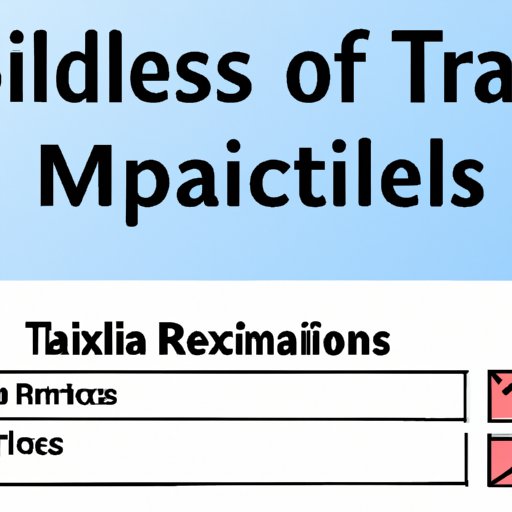I. Introduction
When it comes to tax deductions, every little bit counts. One often overlooked aspect of deductions is mileage, which can add up significantly over the course of a year. Claiming mileage deductions on your taxes can help reduce your tax burden and put some extra money back in your pocket. In this article, we will explore the ins and outs of mileage deductions, providing guidance and tips to help you maximize your deductions and navigate the often confusing world of taxes.
II. Overview of Mileage Deductions
There are three main categories that qualify for mileage deductions: business, medical, and charitable miles. Understanding the rules and limits set by the IRS for each category is crucial to ensure that you are claiming the correct deductions.
Business mileage deductions apply when you use your personal vehicle for business purposes, such as visiting clients or attending meetings. It’s important to keep track of the distance traveled and the purpose of the trip to substantiate your deductions. Similarly, medical mileage deductions can be claimed when traveling to receive medical treatment or for accompanying someone who requires medical care. Lastly, if you volunteer for a qualified charitable organization, you can deduct the mileage traveled while performing volunteer work.
It is essential to familiarize yourself with the specific guidelines provided by the IRS for each type of deduction. The rules and limits can change from year to year, so staying updated is crucial.
III. Accurately Tracking and Documenting Mileage
Keeping accurate records of mileage is essential when it comes to maximizing your deductions and avoiding any discrepancies during an audit. The following strategies can help you effectively track and document your mileage:
1. Maintain a mileage log: Keep a mileage logbook in your vehicle to record the date, starting point, destination, purpose, and miles traveled for each trip. This will serve as evidence to support your deductions and provide a clear picture of your mileage throughout the year.
2. Utilize mileage tracking apps: There are numerous apps available that can simplify the process of tracking mileage. These apps use GPS technology to automatically track your trips and provide accurate reports for tax purposes. Some even integrate with accounting software, making it easier to transfer the data for tax preparation.
3. Save receipts and supporting documents: In addition to a mileage log, save any relevant receipts and documents related to your deductible trips. This includes parking fees, tolls, and other expenses directly associated with your mileage. These documents will help strengthen your case in the event of an audit.
4. Regularly review and reconcile your records: Make it a habit to review and reconcile your mileage records on a regular basis. This will help identify any errors or discrepancies and allow you to correct them in a timely manner.
Remember, accurate tracking and thorough documentation are vital when it comes to claiming mileage deductions on your taxes. In the event of an audit, you will be required to provide evidence to support your claims, so it’s crucial to keep detailed records.
IV. Tips for Maximizing Deductions
In addition to accurately tracking and documenting your mileage, there are several other tips that can help you maximize your deductions:
1. Plan efficient routes: When possible, plan your trips in a way that minimizes the distance traveled. This can help reduce your overall mileage and increase your deductions.
2. Group trips together: If you have multiple errands or business appointments in the same area, try to schedule them on the same day. By grouping your trips together, you can maximize your mileage deductions.
3. Don’t forget additional expenses: Parking fees, tolls, and other expenses incurred during your deductible trips can also be claimed alongside your mileage. These additional deductions can add up and further reduce your tax liability.
4. Consider the standard mileage rate: The IRS offers a standard mileage rate that can be used to calculate deductions. While this is a simplified method, it may not always be the most beneficial. Depending on your personal circumstances, you may find that claiming actual expenses yields a higher deduction. Consult with a tax professional to determine which method is most advantageous for you.
By implementing these tips and strategies, you can make the most of your mileage deductions and potentially save a significant amount on your taxes. Remember to stay informed about any changes to the IRS rules and limits, and consult with a tax professional for personalized advice.
Conclusion
Understanding mileage deductions is a valuable tool for reducing your tax liability. By accurately tracking and documenting your mileage, following the IRS guidelines for each category, and implementing strategies to maximize deductions, you can keep more of your hard-earned money in your pocket. Remember to stay organized, review and reconcile your records regularly, and seek professional advice when needed. With these tips in mind, you will be well on your way to unraveling the mystery of mileage deductions and optimizing your tax savings.
(Note: Is this article not meeting your expectations? Do you have knowledge or insights to share? Unlock new opportunities and expand your reach by joining our authors team. Click Registration to join us and share your expertise with our readers.)
